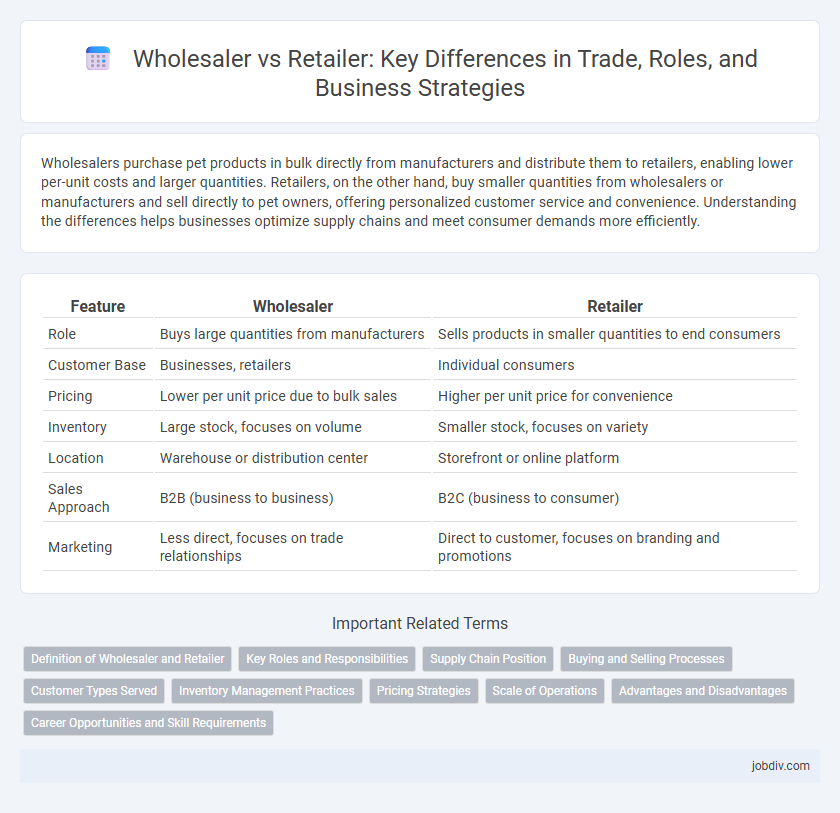Wholesalers purchase pet products in bulk directly from manufacturers and distribute them to retailers, enabling lower per-unit costs and larger quantities. Retailers, on the other hand, buy smaller quantities from wholesalers or manufacturers and sell directly to pet owners, offering personalized customer service and convenience. Understanding the differences helps businesses optimize supply chains and meet consumer demands more efficiently.
Table of Comparison
| Feature | Wholesaler | Retailer |
|---|---|---|
| Role | Buys large quantities from manufacturers | Sells products in smaller quantities to end consumers |
| Customer Base | Businesses, retailers | Individual consumers |
| Pricing | Lower per unit price due to bulk sales | Higher per unit price for convenience |
| Inventory | Large stock, focuses on volume | Smaller stock, focuses on variety |
| Location | Warehouse or distribution center | Storefront or online platform |
| Sales Approach | B2B (business to business) | B2C (business to consumer) |
| Marketing | Less direct, focuses on trade relationships | Direct to customer, focuses on branding and promotions |
Definition of Wholesaler and Retailer
A wholesaler purchases large quantities of goods directly from manufacturers and sells them in bulk to retailers or other businesses, facilitating the supply chain by providing cost-efficient distribution and storage. Retailers buy products from wholesalers or manufacturers and sell them in smaller quantities directly to end consumers, often offering personalized services and a broader shopping experience. The key distinction lies in the target customer: wholesalers serve business clients, whereas retailers deal with individual consumers.
Key Roles and Responsibilities
Wholesalers act as intermediaries by purchasing large quantities of goods directly from manufacturers and distributing them to retailers or other businesses, optimizing supply chain efficiency and reducing transaction costs. Retailers focus on selling products directly to end consumers, providing personalized customer service, managing inventory, and driving sales through marketing and promotions. Both roles are essential for market distribution, with wholesalers facilitating bulk trade and retailers enhancing accessibility and consumer experience.
Supply Chain Position
Wholesalers act as intermediaries within the supply chain by purchasing large quantities of goods directly from manufacturers and distributing them to retailers or other businesses, enabling bulk transactions and reducing distribution costs. Retailers operate at the final stage of the supply chain, selling products in smaller quantities directly to end consumers, focusing on customer experience and demand fulfillment. The supply chain position of wholesalers streamlines inventory management and logistics, while retailers emphasize market responsiveness and retail sales strategies.
Buying and Selling Processes
Wholesalers purchase products in bulk directly from manufacturers, enabling lower per-unit costs and facilitating large-scale distribution to retailers. Retailers buy smaller quantities from wholesalers or manufacturers, tailoring inventory to consumer demand and focusing on final sales to end-users. The buying process for wholesalers emphasizes volume discounts, while retailers prioritize product variety and turnover speed to optimize sales.
Customer Types Served
Wholesalers primarily serve business customers, including retailers, manufacturers, and other merchants, by supplying goods in large quantities at discounted prices. Retailers focus on individual consumers, providing smaller quantities of products tailored to meet the needs of end-users. Understanding these customer types helps businesses optimize their supply chain strategies and target market approaches effectively.
Inventory Management Practices
Wholesalers typically manage larger inventory volumes with a focus on bulk storage, leveraging economies of scale to reduce holding costs and ensuring a steady supply for retailers. Retailers prioritize inventory turnover and demand forecasting to maintain optimal stock levels, minimizing stockouts and overstock situations in high-traffic consumer environments. Advanced inventory management systems, such as just-in-time (JIT) and automated replenishment, are crucial for retailers to balance variety and volume, whereas wholesalers rely more on warehouse optimization and supplier coordination.
Pricing Strategies
Wholesalers typically employ volume-based pricing strategies, offering significant discounts for bulk purchases to attract large buyers and reduce inventory quickly. Retailers use competitive pricing tactics, adjusting prices based on market demand, consumer behavior, and competitor pricing to maximize profit margins and enhance customer retention. Pricing models such as keystone markup are common for retailers, while wholesalers emphasize economies of scale to maintain lower price points.
Scale of Operations
Wholesalers operate on a larger scale by purchasing and distributing bulk quantities of goods to retailers or other businesses, enabling economies of scale and lower per-unit costs. Retailers focus on smaller-scale transactions, selling products directly to end consumers in individual or limited quantities, which requires extensive customer service and marketing efforts. The scale of operations for wholesalers emphasizes volume and supply chain efficiency, while retailers prioritize customer experience and sales diversity.
Advantages and Disadvantages
Wholesalers benefit from bulk purchasing, enabling lower costs and efficient distribution but face challenges in storage and slower cash flow due to large inventory volumes. Retailers gain advantages through direct customer interaction, higher profit margins per unit, and flexibility in product assortment but encounter increased operational costs and greater sensitivity to market trends. Understanding these trade-offs helps businesses optimize their supply chain and market strategies.
Career Opportunities and Skill Requirements
Wholesalers typically require strong negotiation, logistics, and supply chain management skills to handle bulk transactions and large inventory movements, offering career opportunities in procurement, operations, and distribution management. Retailers focus on customer service, sales expertise, and merchandising skills, creating career paths in store management, visual merchandising, and sales analytics. Both sectors demand adaptability and market knowledge but differ significantly in their interaction with customers and inventory scale.
Wholesaler vs Retailer Infographic

 jobdiv.com
jobdiv.com